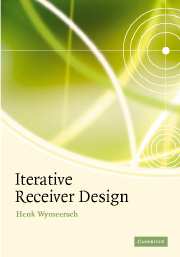Book contents
- Frontmatter
- Contents
- Preface
- Abbreviations
- Notations
- List of algorithms
- 1 Introduction
- 2 Digital communication
- 3 Estimation theory and Monte Carlo techniques
- 4 Factor graphs and the sum–product algorithm
- 5 Statistical inference using factor graphs
- 6 State-space models
- 7 Factor graphs in digital communication
- 8 Decoding
- 9 Demapping
- 10 Equalization–general formulation
- 11 Equalization: single-user, single-antenna communication
- 12 Equalization: multi-antenna communication
- 13 Equalization: multi-user communication
- 14 Synchronization and channel estimation
- 15 Appendices
- References
- Index
5 - Statistical inference using factor graphs
Published online by Cambridge University Press: 08 January 2010
- Frontmatter
- Contents
- Preface
- Abbreviations
- Notations
- List of algorithms
- 1 Introduction
- 2 Digital communication
- 3 Estimation theory and Monte Carlo techniques
- 4 Factor graphs and the sum–product algorithm
- 5 Statistical inference using factor graphs
- 6 State-space models
- 7 Factor graphs in digital communication
- 8 Decoding
- 9 Demapping
- 10 Equalization–general formulation
- 11 Equalization: single-user, single-antenna communication
- 12 Equalization: multi-antenna communication
- 13 Equalization: multi-user communication
- 14 Synchronization and channel estimation
- 15 Appendices
- References
- Index
Summary
Introduction
In the previous two chapters we have introduced estimation theory and factor graphs. Although these two topics may seem disparate, they are closely linked. In this chapter we will use factor graphs to solve estimation problems and, more generally, inference problems. In the context of statistical inference, factor graphs are important for two reasons. First of all, they allow us to reformulate several important inference algorithms in a very elegant way with an all-encompassing, well-defined notation and terminology. As we will see in the future chapters, well-known algorithms such as the forward–backward algorithm, the Viterbi algorithm, the Kalman filter, and the particle filter can all be cast in the factor-graph framework in a very natural way. Secondly, deriving new, optimal (or near-optimal) inference algorithms is fairly straightforward in the factor-graph framework. Applying the SPA on a factor graph relies solely on local computations in basic building blocks. Once we understand the basic building blocks, we need remember only one rule: the sum–product rule. In this chapter, we will go into considerable detail on how to perform inference using factor graphs. Certain aspects of this chapter were inspired by [62].
This chapter is organized as follows.
We start by explaining the various problems of statistical inference in Section 5.2, and then provide a general factor-graph-based framework for solving these problems.
We will deal with how messages should be represented (a topic we glossed over in Chapter 4) in Section 5.3. The representation has many important implications, as will become apparent throughout this book.
[…]
- Type
- Chapter
- Information
- Iterative Receiver Design , pp. 77 - 104Publisher: Cambridge University PressPrint publication year: 2007



